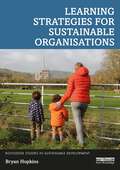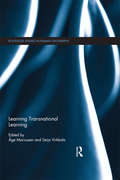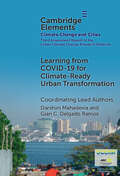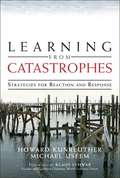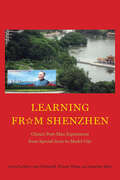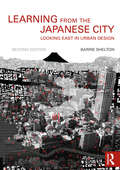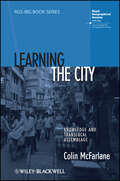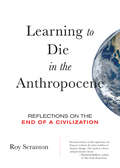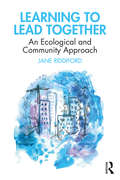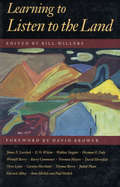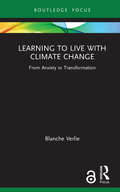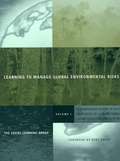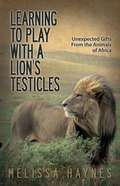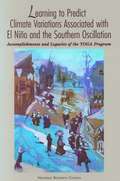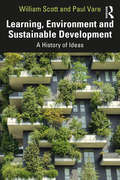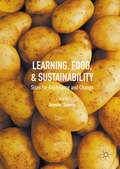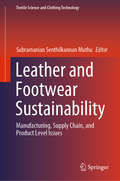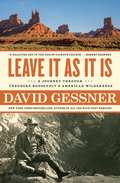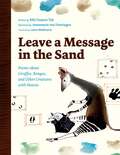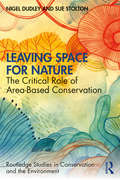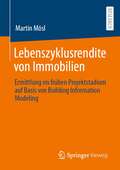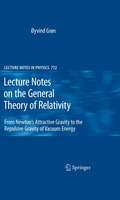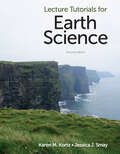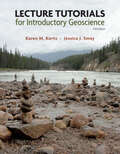- Table View
- List View
Learning Strategies for Sustainable Organisations (Routledge Studies in Sustainable Development)
by Bryan HopkinsLearning Strategies for Sustainable Organisations explores sustainability in the context of organisational practice and its implications for learning. Based on a systems thinking approach, it provides a thorough grounding in the principles of systems thinking and tools that can be used to help implement sustainability-focused learning strategies. Increasingly, organisations are recognising the importance of adapting their practices to become more sustainable. Drawing on the Agenda 2030 Sustainable Development Goals as a framework, new knowledge, skills and attitudes are required to help provide products and services that align with changing social and ecological environments and better serve the communities of which they are a part. This book is a practical guide showing how to facilitate sustainability learning and development within organisations, explaining how to identify gaps in current practice, take into account different contexts and perspectives about what sustainability means, and evaluate results following implementation. Learning resources include chapter summaries, illustrations, reflection points, mind maps and further reading. Written by an independent performance and learning consultant with extensive experience working with international organisations, this book provides a necessary toolkit for human resource development directors, training managers, chief sustainability officers and management consultants specialising in sustainable development.
Learning Transnational Learning (Routledge Studies in Human Geography)
by Åge Mariussen Seija VirkkalaSystems of innovation that are conducted within national borders can preserve inefficient solutions and prevent development. This has led to a feeling that transnational learning strategies are more and more desirable. In practice, the field of transnational learning has been dominated by various policy-making institutions, such as the OECD and European Union, working through different types of policy instruments and programs such as structural funds, open methods of coordination, as well as international research institutions and networks set up by cooperating national governments working on comparative analysis, benchmarking and indicators. This book lays out a set of methods which can further enhance the experience of transnational learning, starting from the sociological ideas promoted by Charles Sabel of learning through monitoring, and by Marie Laure Djelic and others of the “translation” of experiences between different countries. Case studies and examples are collected from three fields: industrial development, tourism and local government.
Learning from COVID-19 for Climate-Ready Urban Transformation (Elements in Climate Change and Cities)
by Darshini Mahadevia Gian C. Delgado-Ramos Janice Barnes Joan Fitzgerald Miho Kamei Kevin LanzaCities have suffered from three years of the COVID-19 pandemic and are increasingly experiencing exacerbated heatwaves, floods, and droughts due to climate change. Going forward, cities need to address both climate and public health crises effectively while reducing poverty and inequity, often in the context of economic pressure and declining levels of trust in government. The COVID-19 pandemic has revealed gaps in city readiness for simultaneous responses to pandemics and climate change, particularly in the Global South. However, these concurrent challenges to cities present an opportunity to reformulate current urbanization patterns and the economies and dynamics they enable. This Element focuses on understanding COVID-19's impact on city systems related to climate change mitigation and adaptation, and vice versa, in terms of warnings, lessons learned, and calls to action. This title is also available as open access on Cambridge Core.
Learning from Catastrophes: Strategies for Reaction and Response
by Michael Useem Howard KunreutherBreakthrough, business-focused techniques for managing the growing risks of catastrophe, from world's leading experts--Indispensable 'extreme risks' guidance for decision-makers in a world that is becoming increasingly unstable. -Powerful assessment models, decision-making techniques, and best practices for building resilience into any organization, public or private. -Edited by the leading experts who recently introduced influential new techniques for managing extreme risks at the World Economic Forum. Events ranging from Hurricane Katrina to the global economic crisis have taught businesspeople an unforgettable lesson: if you don't plan for 'extreme risk,' you endanger your organization's very survival. But how can you plan for events that go far beyond anything that occurs in normal day-to-day business? In Learning from Catastrophes, two renowned experts present the first comprehensive strategic framework for assessing, responding to, and managing extreme risk. Howard Kunreuther and Michael Useem build on their own breakthrough work on mitigating natural disasters, extending it to the challenges faced by real-world enterprises. Along with the contributions of leading experts in risk management, heuristics, and disaster recovery, they identify the behavioral biases and faulty heuristics that mislead decision makers about the likelihood of catastrophe. They go on to identify the hidden links associated with extreme risks, and present techniques for systematically building greater resilience into the organization. The global best-seller The Black Swan told executives that 'once in a lifetime' events are far more common and dangerous than they ever realized. Learning from Catastrophe shows them exactly what to do about it.
Learning from Shenzhen: China’s Post-Mao Experiment from Special Zone to Model City
by Jonathan Bach Mary Ann O'Donnell Winnie WongThis multidisciplinary volume, the first of its kind, presents an account of China’s contemporary transformation via one of its most important yet overlooked cities: Shenzhen, located just north of Hong Kong. In recent decades, Shenzhen has transformed from an experimental site for economic reform into a dominant city at the crossroads of the global economy. The first of China’s special economic zones, Shenzhen is today a UNESCO City of Design and the hub of China’s emerging technology industries. Bringing China studies into dialogue with urban studies, the contributors explore how the post-Mao Chinese appropriation of capitalist logic led to a dramatic remodeling of the Chinese city and collective life in China today. These essays show how urban villages and informal institutions enabled social transformation through cases of public health, labor, architecture, gender, politics, education, and more. Offering scholars and general readers alike an unprecedented look at one of the world’s most dynamic metropolises, this collective history uses the urban case study to explore critical problems and possibilities relevant for modern-day China and beyond.
Learning from the Japanese City: Looking East in Urban Design (Planning, History and Environment Series)
by Barrie SheltonJapanese cities are amongst the most intriguing and confounding anywhere. Their structures, patterns of building and broader visual characteristics defy conventional urban design theories, and the book explores why this is so. Like its cities, Japan’s written language is recognized as one of the most complicated, and the book is unique in revealing how the two are closely related. Set perceptively against a sweep of ideas drawn from history, geography, science, cultural and design theory, Learning from the Japanese City is a highly original exploration of contemporary urbanism that crosses disciplines, scales, time and space. This is a thoroughly revised and much extended version of a book that drew extensive praise in its first edition. Most parts have stood the test of time and remain. A few are replaced or removed; about a hundred figures appear for the first time. Most important is an entirely new (sixth) section. This brings together many of the urban characteristics, otherwise encountered in fragments through the book, in one walkable district of what is arguably Japan’s most convenient metropolis, Nagoya. The interplay between culture, built form and cities remains at the heart of this highly readable book, while a change in subtitle to Looking East in Urban Design reflects increased emphasis on real places and design implications.
Learning the City: Knowledge and Translocal Assemblage (RGS-IBG Book Series #101)
by Colin McFarlaneLearning the City: Translocal Assemblage and Urban Politics critically examines the relationship between knowledge, learning, and urban politics, arguing both for the centrality of learning for political strategies and developing a progressive international urbanism. Presents a distinct approach to conceptualising the city through the lens of urban learning Integrates fieldwork conducted in Mumbai's informal settlements with debates on urban policy, political economy, and development Considers how knowledge and learning are conceived and created in cities Addresses the way knowledge travels and opportunities for learning about urbanism between North and South
Learning to Die in the Anthropocene
by Roy Scranton"In Learning to Die in the Anthropocene, Roy Scranton draws on his experiences in Iraq to confront the grim realities of climate change. The result is a fierce and provocative book."--Elizabeth Kolbert, Pulitzer Prize-winning author of The Sixth Extinction: An Unnatural History"Roy Scranton lucidly articulates the depth of the climate crisis with an honesty that is all too rare, then calls for a reimagined humanism that will help us meet our stormy future with as much decency as we can muster. While I don't share his conclusions about the potential for social movements to drive ambitious mitigation, this is a wise and important challenge from an elegant writer and original thinker. A critical intervention."--Naomi Klein, author of This Changes Everything: Capitalism vs. the Climate Coming home from the war in Iraq, US Army private Roy Scranton thought he'd left the world of strife behind. Then he watched as new calamities struck America, heralding a threat far more dangerous than ISIS or Al Qaeda: Hurricane Katrina, Superstorm Sandy, megadrought--the shock and awe of global warming.Our world is changing. Rising seas, spiking temperatures, and extreme weather imperil global infrastructure, crops, and water supplies. Conflict, famine, plagues, and riots menace from every quarter. From war-stricken Baghdad to the melting Arctic, human-caused climate change poses a danger not only to political and economic stability, but to civilization itself . . . and to what it means to be human. Our greatest enemy, it turns out, is ourselves. The warmer, wetter, more chaotic world we now live in--the Anthropocene--demands a radical new vision of human life.In this bracing response to climate change, Roy Scranton combines memoir, reportage, philosophy, and Zen wisdom to explore what it means to be human in a rapidly evolving world, taking readers on a journey through street protests, the latest findings of earth scientists, a historic UN summit, millennia of geological history, and the persistent vitality of ancient literature. Expanding on his influential New York Times essay (the #1 most-emailed article the day it appeared, and selected for Best American Science and Nature Writing 2014), Scranton responds to the existential problem of global warming by arguing that in order to survive, we must come to terms with our mortality.Plato argued that to philosophize is to learn to die. If that's true, says Scranton, then we have entered humanity's most philosophical age--for this is precisely the problem of the Anthropocene. The trouble now is that we must learn to die not as individuals, but as a civilization.A war veteran, journalist, author, and Princeton PhD candidate, Roy Scranton has published in the New York Times, Wall Street Journal, Rolling Stone, Boston Review, and Theory and Event, and has been interviewed on NPR's Fresh Air, among other media.imes. This compressed, essential text offers both uncomfortable truths and unexpected joy."--McKenzie Wark, author of Molecular Red: Theory for the Anthropocene
Learning to Lead Together: An Ecological and Community Approach
by Jane RiddifordNever before has there been such strong recognition of the importance of community-based green spaces to local communities and urban redevelopment. This book is an autoethnographic account of the challenges and breakthroughs of learning to lead together. The interwoven stories provide first-hand, evocative examples of how an ecological and community approach to organisational development and urban regeneration helped shift the business as usual paradigm. It will help you identify and step beyond individualistic and ‘heroic’ notions of leadership, and will inspire you to find your own way of embracing natural and shared authority. The book focuses on the experiences of developing an environmental education charity in London; Global Generation. It shows how action research, nature practice and storytelling has successfully grown shared purpose, trust and collaboration, both within Global Generation and in the wider community. The style and structure of the book reflects the participatory approach that it presents. The author, Jane Riddiford, deliberately challenges the norms of authorship, which is shaped by the dominant Western narrative – objective, authorless and ‘othered’. This book goes beyond this narrow framework, combining different styles of writing, including traditional and autobiographical storytelling, diary entries and co-writing. Along with practice accounts of what happened, challenges raised and lessons learned, each chapter will also include other people’s descriptions of their experience of being involved in the process.
Learning to Listen to the Land
by William B. WillersIn this inspired collection, some of America's most provocative thinkers and writers reflect on nature and enviornmetnal science--reaching compelling conclusions about humanity's relationship to the earth. Balanced by science and fact,Learning to Listen to the Landexplains the significance of our modern environmental crisis. The authors underscore the necessity forworking within, rather than counter to, our larger ecosystem. Learning to Listen to the Land represents the sounding of an alarm. It's authors call on us to recognize the consequences of our actions, and inactions, and to develop a sense of connection with the earth.
Learning to Live with Climate Change: From Anxiety to Transformation (Routledge Focus on Environment and Sustainability)
by Blanche VerlieThis imaginative and empowering book explores the ways that our emotions entangle us with climate change and offers strategies for engaging with climate anxiety that can contribute to social transformation. Climate educator Blanche Verlie draws on feminist, more-than-human and affect theories to argue that people in high-carbon societies need to learn to ‘live-with’ climate change: to appreciate that human lives are interconnected with the climate, and to cultivate the emotional capacities needed to respond to the climate crisis. Learning to Live with Climate Change explores the cultural, interpersonal and sociological dimensions of ecological distress. The book engages with Australia’s 2019/2020 ‘Black Summer’ of bushfires and smoke, undergraduate students’ experiences of climate change, and contemporary activist movements such as the youth strikes for climate. Verlie outlines how we can collectively attune to, live with, and respond to the unsettling realities of climate collapse while counteracting domineering ideals of ‘climate control.’ This impressive and timely work is both deeply philosophical and immediately practical. Its accessible style and real-world relevance ensure it will be valued by those researching, studying and working in diverse fields such as sustainability education, climate communication, human geography, cultural studies, environmental sociology and eco-psychology, as well as the broader public.
Learning to Manage Global Environmental Risks
by Social Learning GroupThis book examines how ideas, interests, and institutions affect management practice; how management capabilities in other areas affect the ability to deal with environmental issues; and how learning affects society's approach to the global environment.
Learning to Play With a Lion's Testicles
by Melissa HaynesThe cheeky title of Melissa Haynes's story of adventure in Africa, Learning to Play with a Lion's Testicles, earned the book some big publicity on NBC-TV/Late Night with Jimmy Fallon on September 4,2013 where it topped the show's list of "Titles Not to Read" for September 2013. Melissa's book was also a big smash on the March 11, 2014 Ellen Show, where Ellen and guest Ricky Gervais highlighted the book throughout the entire hour. Playing with a lion's testicles: An African saying that means to take foolhardy chances.Melissa, an exhausted executive from the city seeks meaning and purpose from her work, and volunteers for a Big Five conservation project in South Africa. Her boss, an over-zealous ranger, nicknamed the Drill Sergeant, has no patience for city folk, especially if they're women, and tries to send her packing on day one. But Melissa stands her ground with grit and determination, however shaky it may be.Conflict soon sets the pace with a cast filled with predatory cats, violent elephants, and an on-going battle of wits with the Drill Sergeant. Even Mother Nature pounds the reserve with the worst storm in a century. But the most enduring and profound conflict is the internal battle going on within Melissa, as she tries to come to terms with the guilt surrounding her mother's death. When death grips the game reserve, it is the very animals Melissa has come to save that end up saving her.For the reader who has ever dreamed of going to Africa or knows the pain of loss and guilt, LEARNING TO PLAY WITH A LION'S TESTICLES will fill your soul.
Learning to Predict Climate Variations Associated with El Niño and the Southern Oscillation: Accomplishments and Legacies of the TOGA Program
by Advisory Panel for the Tropical Oceans Global Atmosphere ProgramThe TOGA (Tropical Ocean and Global Atmosphere) Program was designed to study short-term climate variations. A 10-year international program, TOGA made El Nino a household word. This book chronicles the cooperative efforts of oceanographers and meteorologists, several U.S. government agencies, many other nations, and international scientific organizations to study El Nino and the Southern Oscillation (ENSO).It describes the progression from being unable to detect the development of large climate variations to being able to make and use rudimentary climate predictions, especially for some tropical countries. It examines the development of the TOGA Program, evaluates its accomplishments, describes U.S. participation in the program, and makes general recommendations for developing better understanding and predictions of climate variations on seasonal to interannual time scales.
Learning ‘from’ and ‘with’ the Locals: Traditional Knowledge Systems for Environmental Sustainability in the Himalayas (Advances in Asian Human-Environmental Research)
by Pardeep Singh Anwesha BorthakurThis book aims to capture the fading traditional knowledge systems of local and indigenous communities in the Himalayas. As many of these practices are at risk of disappearing, the book serves as a valuable record. It encourages readers to reflect on the implications of such knowledge for environmental sustainability today. Focusing on one of the most crucial mountain ranges globally, the book emphasizes the importance of learning ‘from’ and ‘with’ the locals about their lived experiences in the Himalayas. Understanding their unique set of traditional knowledge and technologies is crucial for building climate resilience and effective environmental management. With contributions from experts across the Himalayan region, the book strives for a comprehensive grasp of environmental challenges and potential solutions. Beyond documentation, the goal is to explore opportunities for integrating traditional knowledge with modern scientific approaches. Recognizing the urgency, the book advocates for the preservation of local and indigenous knowledge to address the ongoing global environmental crisis.
Learning, Environment and Sustainable Development: A History of Ideas
by William Scott Paul VareThis book is an introduction to the long history of human learning, the environment and sustainable development – about our struggles with the natural world: first for survival, then for dominance, currently for self-preservation, and in future perhaps, even for long-term, mutually beneficial co-existence. It charts the long arc of human–environment relationships through the specific lens of human learning, putting on record many of the people, ideas and events that have contributed, often unwittingly, to the global movement for sustainable development. Human learning has always had a focus on the environment. It’s something we’ve been engaged in ever since we began interacting with our surroundings and thinking about the impacts, outcomes and consequences of our actions and interactions. This unique story told by the authors is episodic rather than a connected, linear account; it probes, questions and re-examines familiar issues from novel perspectives, and looks ahead. The book is of particular interest to those studying (and teaching) courses with a focus on socio-economic and environmental sustainability, and non-governmental organisations whose work brings them face-to-face with the general public and social enterprises.
Learning, Food, and Sustainability
by Jennifer SumnerThis edited volume explores the intersection of learning and food, both within and beyond the classroom, all within the context of sustainability. Taking a broad pedagogical approach to the question of food, it focuses on learning and change in a number of key sites including schools, homes, communities, and social movements, keeping in mind that we need to learn our way out of our current unsustainable food system and in to more sustainable alternatives.
Leather and Footwear Sustainability: Manufacturing, Supply Chain, and Product Level Issues (Textile Science and Clothing Technology)
by Subramanian Senthilkannan MuthuThis book examines the manufacturing, supply chain and product-level sustainability of leather and footwear products. This book deals with the environmental and chemical sustainability aspects pertaining to the tanning supply chain and the related mitigation measures. The book also explores interesting areas of leather and footwear sustainability, such as waste & the 3R’s and their certification for sustainability. At the product level, the book covers advanced topics like the circular economy and blockchain technology for leather and footwear products and addresses innovation development and eco-material use in footwear by investigating environmental sustainability and the use of bacterial cellulose, a potential sustainable alternative for footwear and leather products.
Leave It As It Is: A Journey Through Theodore Roosevelt's American Wilderness
by David GessnerBestselling author David Gessner&’s wilderness road trip inspired by America&’s greatest conservationist, Theodore Roosevelt, is &“a rallying cry in the age of climate change&” (Robert Redford).&“Leave it as it is,&” Theodore Roosevelt announced while viewing the Grand Canyon for the first time. &“The ages have been at work on it and man can only mar it.&” Roosevelt&’s pronouncement signaled the beginning of an environmental fight that still wages today. To reconnect with the American wilderness and with the president who courageously protected it, acclaimed nature writer and New York Times bestselling author David Gessner embarks on a great American road trip guided by Roosevelt&’s crusading environmental legacy. Gessner travels to the Dakota badlands where Roosevelt awakened as a naturalist; to Yellowstone, Yosemite, and the Grand Canyon where Roosevelt escaped during the grind of his reelection tour; and finally, to Bears Ears, Utah, a monument proposed by Native Tribes that is currently embroiled in a national conservation fight. Along the way, Gessner questions and reimagines Roosevelt&’s vision for today&’s lands. &“Insightful, observant, and wry,&” (BookPage) Leave It As It Is offers an arresting history of Roosevelt&’s pioneering conservationism, a powerful call to arms, and a profound meditation on our environmental future.
Leave a Message in the Sand: Poems about Giraffes, Bongos, and Other Creatures with Hooves
by Bibi Dumon TakWhat would a boar text to a pig, a camel post on a dating site, or a goat shout from the mountaintops? In this unforgettable poetry collection, even-toed ungulates take the spotlight. Ever asked a giraffe about the clouds, read an okapi&’s letter to the editor, or debated which gnu would win the race across the Serengeti? Playful poems and whimsical illustrations feature hoofed creatures from all around the world, from Siberian musk deer to African dik-diks to South American vicuñas. Weaving together humor, scientific detail, and a poignant concern for conservation, Leave a Message in the Sand introduces readers to wild creatures with even wilder things to say.
Leaving Space for Nature: The Critical Role of Area-Based Conservation (Routledge Studies in Conservation and the Environment)
by Nigel Dudley Sue StoltonThis book provides the first contemporary assessment of area-based conservation and its implications for nature and society. Now covering 15 per cent of the land surface and a growing area of ocean, the creation of protected areas is one of the fastest conscious changes in land management in history. But this has come at a cost, including a backlash from human rights organisations about the social impacts of protected areas. At the same time, a range of new types of area-based conservation has emerged, based on indigenous people’s territories, local community lands and a new designation of “other effective area-based conservation measures”. This book provides a concise overview of the status and possible futures of area-based conservation. With many people calling for half the earth’s land surface to remain in a natural condition, this book taps into the urgent debate about the feasibility of such an aim and the ways in which such land might be managed. It provides a timely contribution by people who have been at the centre of the debate for the last twenty years. Building on the authors’ large personal knowledge, the book draws on global case studies where the authors have firsthand experience, including Yosemite National Park (USA), Blue Mountains National Park (Australia), Bwindi National Park (Uganda), Chingaza National Park (Colombia), Ustyart Plateau (Kazakhstan), Snowdonia National Park (Wales) and many more. This book is essential reading for students, academics and practitioners interested in conservation and its impact on society.
Lebenszyklusrendite von Immobilien: Ermittlung im frühen Projektstadium auf Basis von Building Information Modeling
by Martin MöslZur Sicherstellung des Werterhalts von Immobilien werden zunehmend nachhaltige Aspekte im Planungsprozess berücksichtigt. Dies erfordert bereits in der Phase der Projektentwicklung eine ganzheitliche Betrachtung sowohl der zur Errichtung und zum Betrieb eines Gebäudes entstehenden Aufwände bestehend aus Errichtungs- und Folgekosten (=Lebenszykluskosten) als auch der in der Betriebsphase zu erwartenden Erträge. Durch die Gegenüberstellung der Aufwände zu den Erträgen ergibt sich die Lebenszyklusrendite (LZR) als Faktor zur Prognose der Rentabilität einer Investition. Das Ziel dieser Arbeit ist die Entwicklung einer Methodik zur kostenoptimierten und lebenszyklusorientierten Steuerung der Gebäudeplanung entweder in der Phase der Projektentwicklung oder in einer frühen Planungsphase in Kombination mit der Anwendung von "Building Information Modeling" (BIM). Als Grundlage für diese Methodik wird die frühzeitige Einbindung der zu diesem frühen Zeitpunkt vorhandenen Erkenntnisse in ein Bauwerksmodell untersucht, um eine Steigerung der Produktivität und Effizienz in den nachfolgenden Planungsphasen zu erreichen. Die automatisierte Ermittlung der LZR erfolgt durch ein seitens des Autors entwickeltes Software Tool.
Lecture Notes on the General Theory of Relativity
by Øyvind GrønThis book is the result of more than twenty years of lecturing a master course on the General Theory of Relativity at the University of Oslo, Norway, by Dr. Øyvind Grøn. The text has been continuously updated by Dr. Grøn and is written so students can follow the deductions all the way throughout the book. The conceptual content of the general theory of relativity is presented briefly but reasonably and completely. Both bachelor students and master students will find the text useful as the manuscript is organized to easily find the topics one wants to read about, with separate lists of contents, figures, definitions, examples, and an index.
Lecture Tutorials for Earth Science
by Karen Kortz Jessica SmayGet actively involved in the practical application of earth science concepts as you learn to navigate common pitfalls and misconceptions related to content from any introductory earth science course with Lecture Tutorials in Earth Science.
Lecture Tutorials for Introductory Geoscience
by Karen Kortz Jessica SmayA set of brief worksheets designed to be completed by students working alone or in groups, Lecture Tutorials in Introductory Geoscience engage students in the learning process and make abstract concepts real. Through the use of effective questioning, step-by-step learning, and a progression of simple-to-complex visuals, Lecture Tutorials help students construct correct scientific ideas about often-difficult topics, while dispelling common misconceptions. Research based on extensive classroom use shows that Lecture Tutorials increase student learning more than just a lecture alone.
